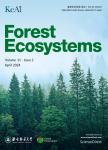Gap models across micro-to mega-scales of time and space:examples of Tansley’s ecosystem concept
Gap models across micro-to mega-scales of time and space:examples of Tansley’s ecosystem concept作者机构:University of Virginia291 McCormick RdCharlottesvilleVA 22904USA NASA Goddard Space Flight Center8800 Greenbelt RdGreenbeltMD 20771USA Department of Ecology and Evolutionary BiologyUniversity of CaliforniaIrvineCAUSA Department of GeologicalEnvironmentaland Marine SciencesRider University2083 Lawrenceville RdLawrencevilleNJ 08648USA College of Plant Science and TechnologyHuazhong Agriculture UniversityWuhanHubeiChina Jet Propulsion LaboratoryCalifornia Institute of TechnologyPasadenaCA 91109USA Beijing Normal UniversityJingshi Keji Building B-811NO.12 Xueyuan South RoadHaidian DistrictBeijing 100875China.
出 版 物:《Forest Ecosystems》 (森林生态系统(英文版))
年 卷 期:2020年第7卷第2期
页 面:172-189页
核心收录:
学科分类:0907[农学-林学] 07[理学] 09[农学] 070602[理学-大气物理学与大气环境] 0710[理学-生物学] 0830[工学-环境科学与工程(可授工学、理学、农学学位)] 0829[工学-林业工程] 0903[农学-农业资源与环境] 0706[理学-大气科学] 0901[农学-作物学] 0833[工学-城乡规划学] 0713[理学-生态学] 0834[工学-风景园林学(可授工学、农学学位)]
基 金:funded by the USA NASA grant NNH16ZDA001N-ESUSPI USA NASA grant WBS:509496.02.08.09.66 USA NASA ABoVE grant NNX17AE44G USA DoD SERDP grant RC18-1183 USA NASA grant(IDS-80NSSC17K0110) USA NSF grant(AGS-1837891) USA NSF-ATMO 1837891 USA NSF Hydrologic Sciences grant 1561473。
主 题:Pollution Climate change Global forest productivity Individual-based models Ecological scale Forest dynamics
摘 要:Background:Gap models are individual-based models for forests.They simulate dynamic multispecies assemblages over multiple tree-generations and predict forest responses to altered environmental conditions.Their development emphases designation of the significant biological and ecological processes at appropriate time/space scales.Conceptually,they are with consistent with A.G.Tansley’s original definition ofthe ecosystem.Results:An example microscale application inspects feedbacks among terrestrial vegetation change,air-quality changes from the vegetation’s release of volatile organic compounds(VOC),and climate change effects on ecosystem production of VOC’s.Gap models can allocate canopy photosynthate to the individual trees whose leaves form the vertical leaf-area profiles.VOC release depends strongly on leaf physiology by species of these trees.Leaf-level VOC emissions increase with climate-warming.Species composition change lowers the abundance of VOC-emitting taxa.In interactions among ecosystem functions and biosphere/atmosphere exchanges,community composition responses can outweigh physiological responses.This contradicts previous studies that emphasize the warming-induced impacts on leaf function.As a mesoscale example,the changes in climate(warming)on forests including pest-insect dynamics demonstrates changes on the both the tree and the insect populations.This is but one of many cases that involve using a gap model to simulate changes in spatial units typical of sampling plots and scaling these to landscape and regional levels.As this is the typical application scale for gap models,other examples are identified.The insect/climatechange can be scaled to regional consequences by simulating survey plots across a continental or subcontinental zone.Forest inventories at these scales are often conducted using independent survey plots distributed across a region.Model construction that mimics this sample design avoids the difficulties in modelling spatial interactions,but we also discuss simulation at these scales with contagion effects.Conclusions:At the global-scale,successful simulations to date have used functional types of plants,rather than tree species.In a final application,the fine-scale predictions of a gap model are compared with data from micrometeorological eddy-covariance towers and then scaled-up to produce maps of global patterns of evapotranspiration,net primary production,gross primary production and respiration.New active-remote-sensing instruments provide opportunities to test these global predictions.



